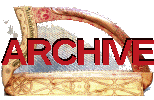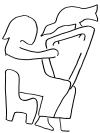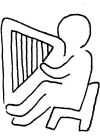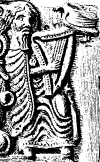
|
It is impossible to pin down the origins of the Gaelic harp; the historical and archaeological record does not provide us with evidence of the invention of the instrument, but instead shows shows us fleeting glimpses of a thriving tradition.
There are historical records of stringed instruments in Ireland from the 6th century onwards. For example, the earliest Irish law codes, dating from the 6th or 7th century AD, specify the high status of a cruit player1. A law tract of c. 700AD describes cruit players sitting with poets in positions of honour at the royal banquet, away from the common entertainers. And in 721AD, Fergal mac Maíle-dúin judges his sons' moral characters by the different types of cruit playing that he hears in their houses2.
Unfortunately though, these passing references to the cruit and timpán do not bother to explain what either was actually like, or what the difference between them was. All we can be sure of is that they were both musical instruments with metal strings3, and that they and the people who played them had a very high status in early Gaelic society.
There are also pictures of stringed instrument players, and while we can't just assume that they were made as realistic portraits of actual performers and instruments4, we can still get some impression of how different instruments were imagined at the time. The stone carvings are very worn, and there is no detail - we can usually only see a fuzzy outline of a figure with a vaguely shaped object on their knee5.

Cross of
Muiredeach
Two of the Irish stone carvings, the Cross of Muiredeach, Monasterboice, and the South cross at Kells, seem to show triangular framed instruments. Although their sides are all straight unlike the curving profile of surviving Gaelic harps, they look more like harps than lyres6. They can be compared with later unambiguous depictions of Gaelic harps, such as the Shrine of St. Mogue (see below); the Cross of Muiredeach even shows the same bird perched on the end of the harp, just like the St. Mogue depiction. The word cruit may refer to these harps7.

Monifieth
In Scotland there is also a number of stone depictions of triangular harps, rectangular lyres and vaguely oblong stringed instruments from the 9th and 10th centuries. Many are in the south-east, and academics often describe them as "Pictish"8. Some of the harps are all straight-sided, like the Monifieth stone shown here; others have a curving forepillar. It is not clear, either from the depictions themselves, or from their historical and cultural context, if these might belong to the Gaelic harp tradition, or whether they would have been gut-strung ancestors of later European harps9.

Shrine of
St. Mogue
By the 11th century we are on much firmer ground. The metal relief picture of David playing the harp from the Shrine of St Mogue (Breac Maedóic), usually dated c.1000AD, clearly shows a Gaelic harp. The harp is of a substantial size, held between the knees, and reaching to the player's chin; it has a strong bowed forepillar with a central T-section carved with eel heads; it has a bulging belly on the soundbox and the curved neck seems to have a metal strip to hold the tuning pins - all features of the surviving instruments from perhaps the 15th century and later10. It is played on the left shoulder with the left hand in the treble and the right hand in the bass, a distinctive feature of Gaelic harp performance practice up to the 19th century11.
Needless to say, that with so much uncertainty over the form and naming of the instrument in the early medieval period, we really have no idea of what music was played on it. The best we can suggest is that the harper would play in some way to accompany the singing of Gaelic poetry in praise of their king or lord.